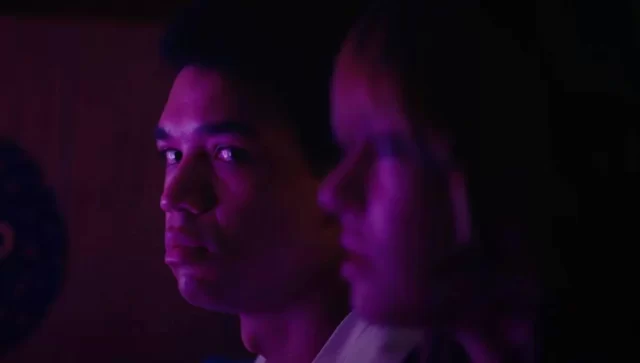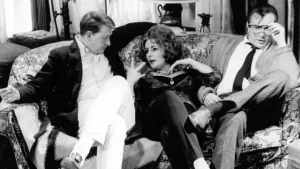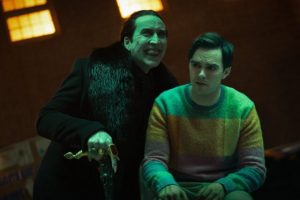
The post I Saw the TV Glow: Don’t Sit So Close, by Scott Nye appeared first on Battleship Pretension.
For the past twenty years, and exploding further in the days of streaming, most everyone you meet seems to be addicted to some TV show. It’s one of the easier addictions to feed – if it’s not already on a service you subscribe to, a month’s use is available at the click of a button for, at most, a fairly modest fee. In the 1990s, however, TV devotion required a genuine compulsion – you had to sit down at a specific time and day of the week, or be pretty handy with your VCR’s labyrinthine recording settings, to keep up week to week with shows that, generally, did not require such close attention, but were often ready to reward it. Those who gave in could easily wrap their lives around it, spending hours dissecting the world on nascent internet forums and chat rooms, unless they happened to be fortunate enough to have a friend (and it was often just one friend) who watched it too.
If you don’t find this sort of minutia all that interesting to learn about or recall, you might not be the audience for I Saw the TV Glow, Jane Schoenbrun’s second narrative feature. It follows a young boy named Owen (Ian Foreman, later Justice Smith) as he moves through high school and young adulthood, starting in the late 1990s, under the influence of The Pink Opaque, a fictional supernatural teen drama. As his fervor for the series grows, his real life begins to feel a touch supernatural itself, until suddenly the show is canceled and, worse, the girl who introduced him to it (Brigette Lundy-Paine) moves away.
Those who saw Schoenbrun’s first narrative feature, We’re All Going to the World’s Fair, will recognize a thematic kinship at play. But where that film more abstractly and hauntingly explored a more common phenomena – the addiction to internet urban legends and dark-web conspiracies that has seized people of every demographic – at a suspicious remove from its medium, I Saw the TV Glow is almost indecipherable to those who don’t hold ground-in emotional response to words like “episode,” “season,” “tape,” or “DVD chapter.” Reverential of the fandom spurred by shows like Buffy the Vampire Slayer, Angel, Roswell, and Charmed to the point of piety, the film is the precise result of what every adult warned about when they said too much TV would rot your brain. Its faux-poetic monologues, too common to second features building on instant acclaim, are further doomed in the mouths of Justice and Lundy-Paine, neither of whom are capable of rendering an honest emotion (until Smith’s late-film breakdown, which is far too much, too late), nor is Schoenbrun’s film interested in opening them up beyond their monotonous tones.
Buried in more high-minded allusions/asperations to David Lynch (a spooky bar with aggressively haunting music), David Cronenberg (pick your favorite visual metaphor from Videodrome), and Gregg Araki (almost too pervasive to isolate), Schoenbrun does miraculously escape with an aesthetic somewhat their own, albeit a higher-budget gloss on what World’s Fair accomplished with far fewer resources. Shot by A Thousand and One cinematographer Eric Yue with grandeur and a whole lot of ultra-saturated lighting set to a soundtrack I will absolutely be playing on repeat, the film is immediately, undeniably hypnotic.
But where World’s Fair communicated its dread in expertly-hushed performances, TV Glow’s more experienced cast nevertheless emerges more amateurish, the familiar case of too much training overly embellishing good instincts. Justice Smith has bounced around high-budget genre fare (a couple Jurassic Worlds, a Pokémon, a Dungeons and Dragons) and a handful of more modest dramas (The Voyeurs, All the Bright Places, Sharper), and has struggled to define his onscreen voice. He’s attempting to claim more here, in part by carrying a character through many years of life experience, but comes away only with cheap physical signifiers and a desperate antisocial isolation that stands at odds with the basic biographical details the film relays. His every line reading ostentatiously plays to theme, worked over until it’s ground down, too much reflection and not enough reflexes.
Lundy-Paine comes to this with less experience – supporting roles in The Glass Castle, Bombshell, and Bill & Ted Face the Music that are too functional to be notable, and a run on the Netflix series Atypical I can’t speak to – and an even greater ask. The “mysterious/troubled/vanishing girl” trope is overplayed in the very media the film worships, and Maddy has every trait that character has ever had. Abusive stepfather? Check. Connecting to our main character through pop culture? Very premise of the film. Emotionally unavailable until she needs help? One hundred percent. Cycles through hair styles in place of an actual arc? Buddy, what else are they gonna do? Any actor would struggle to find their footing here, and Lundy-Paine doesn’t even have the innate idiosyncrasies that could cover for their lack of facility to carry it out.
Schoenbrun came on the scene with one of the best debut narrative films of the decade thus far, but retreading the same emotional, thematic, and narrative well that they so successfully captured already only emphasizes the shortcomings in moving to larger-scale filmmaking. In further burying the film in what others have accomplished elsewhere, its imitative streak pulses through all the more fervently. In resting its emotional strength on two performers ill-suited to the tone they’re trying to strike, the earnestness the film seeks to submerge in instead floats on the surface, exposing its lamentable triviality. In a scene late in the film, revisiting The Pink Opaque and finding it doesn’t live up to his childhood vision of it, Owen mourns in didactic voiceover, “it was embarrassing.” Hear, hear.
The post I Saw the TV Glow: Don’t Sit So Close, by Scott Nye first appeared on Battleship Pretension.
The post I Saw the TV Glow: Don’t Sit So Close, by Scott Nye appeared first on Battleship Pretension.
![Fear Street Part One: 1994 [2021] ★★½](https://recognizecity.com/wp-content/uploads/2021/07/Fear_Street_Part_1__1994_A096C003_190405_R2QE_1.153.1_R_rgb-H-2021-300x169.webp)

